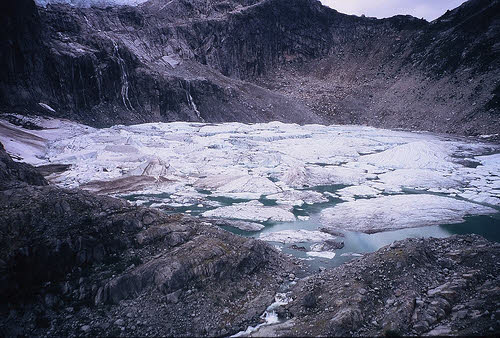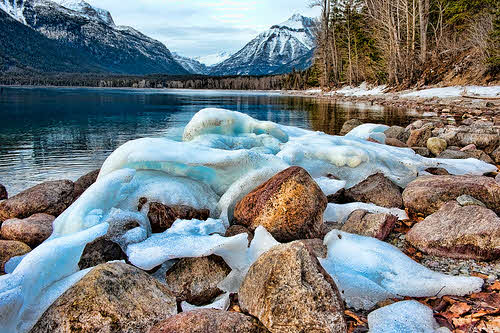Melting mountain glaciers contribute to sea level rise as well, but they are of more immediate concern because of their roles in the everyday lives of millions of people. They provide drinking water for villages and cities, irrigation water for farms, and fuel for hydropower plants. These vital services are in jeopardy because mountain glaciers worldwide are shrinking at accelerating rates. For instance, 37 reference glaciers studied by the World Glacier Monitoring Service shrank three times faster from 2000 to 2009 than from 1980 to 1989. (See data.)
The glaciers in the Himalayas—the largest concentration of ice outside of the two poles—have been dubbed Asia’s “water towers” because of their large water storage capacity. Their runoff feeds Asia’s great rivers, including the Indus, Ganges, and Brahmaputra, which support hundreds of millions of people. Climbers attracted to the one-of-a-kind peaks tell their own stories of melting ice. In many places, what had been blinding white ice and snow fields in the days of the first explorers are now bare rock. More avalanches and more crevasses add risk to already dangerous treks. Data collected by the Chinese Academy of Sciences validate these anecdotes, showing that glacier melt in the Eastern and Central Himalayas has sped up. This will continue as temperatures rise.
Glaciers in the Alps perform a similar water tower function for Europe, and they too are shrinking. Switzerland’s Great Aletsch glacier, the largest in the Alps, has retreated by more than 2 kilometers since 1900. In Germany, a local ski company concerned by the rapid shrinkage of Zugspitze glacier resorted to covering the ice with a 9,000-square-meter reflective blanket. But this is just a Band-Aid; without addressing the real problem of rising temperature, 90 percent of all Alpine glaciers could be wiped out by 2100. Such a dramatic loss can already be seen in the nearby Spanish Pyrenees Mountains, where close to 90 percent of the glacier cover has disappeared over the past century.
In the United States, almost all of Alaska’s glaciers are retreating or thinning. For example, data collected at Gulkana glacier each year since 1966 reveal an ice loss trend that has sped up since the early 1990s. In Montana, Glacier National Park may be “glacier” in name only within two decades. Only 25 of the park’s 150 original glaciers remain.
Nearly all of the world’s tropical glaciers are found in South America in the Andes. Rising temperatures have more than tripled the rate of ice loss from these glaciers since the mid-1970s. In Peru, more than 2 million people depend on runoff from the Cordillera Blanca (the White Range). As the mountain range’s glaciers began to waste away, water runoff temporarily increased. But glaciologist Michel Baraer of McGill University in Canada estimates that runoff has already peaked and is now in decline. Bolivia’s famous Chacaltaya glacier, once a popular ski site, can now be found only on old maps. The runoff from Zongo glacier flows through 10 hydropower plants that currently generate some 25 percent of Bolivia’s electricity. But Zongo’s ice is retreating by 9 meters per year. As water supplies dwindle, competition among hydropower stations, farmers, and cities will get worse.
The last remaining glaciers in the tropical Pacific, on Indonesia’s Puncak Jaya Mountain, also are melting fast. Between 1936 and 2006, this mountain lost close to 80 percent of its ice cover. During world-renowned glaciologist Lonnie Thompson’s recent expedition to sample the ice before it disappears—along with the historical climate data trapped inside the ice—heavy rains thinned the ice around his campsite by 30 centimeters in just 13 days.
Tropical glaciers in Africa are wasting away too. Less than 10 percent of the original ice cover remains atop Mount Kenya. In 2009, Nairobi had rolling blackouts due to the diminished runoff from the mountain flowing to hydropower stations. The problems are more than just practical; the glacier has long held cultural and spiritual significance. Neighboring Uganda’s Rwenzori Mountains could be ice-free within 20 years.
The race is on between disappearing ice, which is melting faster than predicted, and reductions in carbon emissions, which is happening slower than hoped. The world will need a World War II–type mobilization to shift from climate-disrupting fossil fuels to renewable sources of energy if we are to stand a chance of preventing runaway global warming and unstoppable melting.
For a plan to stabilize the Earth’s climate, see “Time for Plan B.”
Copyright © 2013 Earth Policy Institute
Image credit: Shakeskc via photopin cc


